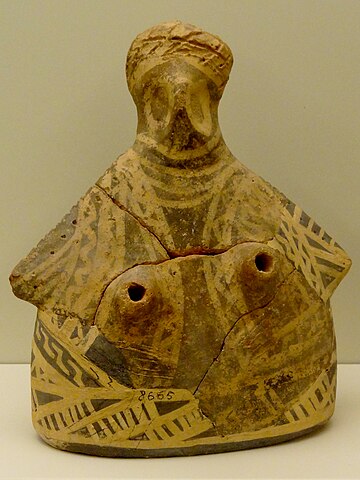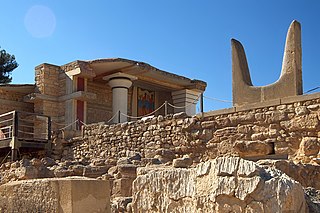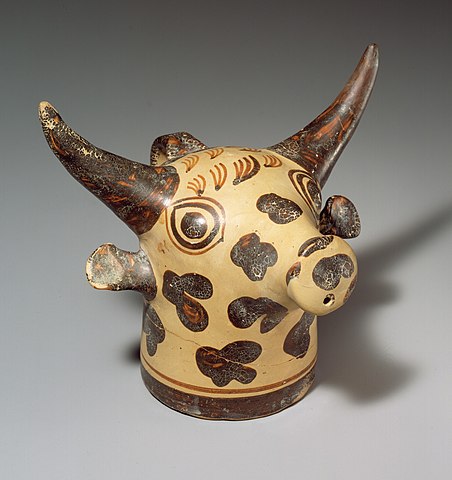Ariadne's Tribe: Minoan Spirituality for the Modern World
Walk the sacred labyrinth with Ariadne, the Minotaur, the Great Mothers, Dionysus, and the rest of the Minoan family of deities. Ariadne's Tribe is an independent spiritual tradition that brings the deities of the ancient Minoans alive in the modern world. We're a revivalist tradition, not a reconstructionist one. We rely heavily on shared gnosis and the practical realities of Paganism in the modern world. Ariadne's thread reaches across the millennia to connect us with the divine. Will you follow where it leads?
Find out all about Ariadne's Tribe at ariadnestribe.com. We're an inclusive, welcoming tradition, open to all who share our love for the Minoan deities and respect for our fellow human beings.
Topless Minoan Women: Not What You Think
The modern Pagan world is awash in womb symbolism, and I can’t say I mind. After all, the feminine side of the divine has been almost entirely ignored by the major religions of the past few centuries. OK, millennia.
But the ancients didn’t always focus on the womb as the central symbol of the feminine, either divine or mundane. Take, for instance, the Minoans and their reverence for the breast.
You’re probably familiar with the frescoes and figurines from ancient Crete that depict women in open-front tops, displaying their breasts for all to see.
We modern folks may feel that the exposed breasts found throughout ancient Minoan art are provocative, but the Minoans probably didn’t feel that way. Just as the Victorians found women’s legs to be terribly sexy simply because they were normally covered and hidden, we respond the same way to women’s breasts.
But in Minoan society, women frequently went topless, just as men did, so that would have been an ordinary sight, and of course ancient women nursed their babies, so that would have been common and not provocative or controversial either. It wouldn't have been sexy so much as normal.
Nudity, partial or full, was common in the Bronze Age Mediterranean - just have a look at Egyptian art, for instance. Back then, the human body simply didn't have the level of shame associated with it that came with later cultures and religions.
But when the priestesses of ancient Crete bared their breasts in a ritual setting, that act may have had deeper meaning as well. We think its purpose was to remind everyone of the role that human and animal mothers play in the nurturing and nourishing of their offspring, and thus of the way in which the Great Mother nourishes us all.
Think, for instance, of the Milky Way, that pale white spattery streak across the sky that's visible to those of us who are lucky enough not to be stuck in light-polluted areas.
Many ancient cultures, including the Minoans, believed the Milky Way was formed when the Great Mother’s milk spurted in response to her baby’s crying (this actually happens in real life to nursing mothers, with predictable soggy-clothing results). On Crete, that Great Mother was Rhea, and her baby was the infant god Dionysus.
In addition to the topless female figures, Minoan art offers other representations of the nurturing of a nursing mother. There’s this lovely sculptured faience plaque of a goat suckling her kid; the artist depicted the animals with great precision and grace.

On one level this is just a beautiful representation of mother-nurture in the natural world, but on another level it may be a depiction of the goat-goddess Amalthea, Rhea’s twin/double and alter-ego who nursed the infant Dionysus.
There's a similar faience plaque from Knossos showing a cow suckling a calf (a pointer towards Europa or Pasiphae, perhaps?) and a number of images on stone seals showing cattle, goats, and deer suckling their young. So this was a common theme in Minoan art.
One of my favorite ways Minoan artists portrayed the nurturing and nourishing qualities of the Great Mother was through some interesting pitchers called breast rhytons. These pitchers were made to look like women and were designed so the liquid poured out through the breasts on the front of the pitcher.
These breast rhytons were likely used to pour ritual libations, both to ask the Great Mothers for favors and to thank them for their generous gifts.

There’s another, equally important symbol in Minoan art that’s directly associated with the breast and nurturing, though the connection might not be immediately obvious to modern folks.
When you think of the temple complex at Knossos, what kind of image do you see in your mind’s eye? What symbol decorates the tops of all the walls? That’s right, the giant sacred horns. Bear with me for a bit and I’ll explain.

These days, when we envision cattle, we tend to think of bulls as having horns and cows as being hornless. But it hasn’t always been that way. All cattle – both male and female – originally had horns. In fact, that was the case until just over a century ago. When ranchers began crowding cattle together in small enclosures, the horns became a danger, so they began the practice of polling the cattle, either surgically removing the horns or breeding them out.
But back in ancient Crete, horns symbolized the cow just as often as they did the bull.
The Minoans' neighbors to the south, the Egyptians, placed beautifully-curving cow horns (NOT bull horns) on Hathor’s head to show that she was a source of nurture and nourishment. The Minoans likewise created depictions of the Moon-Cow, whom we in Ariadne's Tribe call Europa. The horns atop the shrines and temple walls in ancient Crete are just as likely to connote the Moon-Cow as they are the Moon-Bull (the famed and much-maligned Minotaur).
The ancient Minoans also created many rhytons (pitchers) shaped like horned bovine heads, designed so the liquid pours out the mouth. Some of these look like cow heads, and some look like bull heads; you'll find examples of both here.
Some don't have enough distinctive features to allow us to determine whether they're meant to be male or female (or both or neither). The ones that look like cows, not bulls, bear obvious symbolism about nurturing and nourishing. If you had a pitcher that looked like a cow's head and someone poured milk out of it, what would that make you think of?

The Minoans also made cone-shaped ceramic and stone rhytons like this one, used to make libations (ritual offerings of liquids):

This type of rhyton has a hole in the base. It would have been stoppered to fill it. Then, when it was time to make the libation, the stopper would be removed and the liquid would pour out the bottom, like milk from a teat (cow, sheep, goat - or human).
This is one of the less obvious aspects of breast symbolism in Minoan art, but once you know it's there, you can't unsee it.
I really like the idea of the Great Mothers nourishing us all, and I find beauty in the images the Minoans used to convey this idea.
We all come from mothers, and all of us can use the Minoans' example to inspire us so that we can nurture and nourish each other, both literally and figuratively, throughout our lives.
Comments
-
Please login first in order for you to submit comments




















